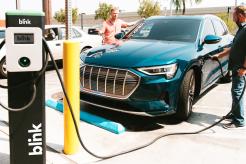Electric vehicles (EVs) are key to decarbonizing road transport. Road transport accounts for 16% of global emissions, and reducing emissions is essential to the fight against climate change.
EV sales are growing exponentially as auto manufacturers produce more models and improve performance and range. This article summarizes the types of EVs currently available to the passenger market.
Conventional Hybrid Electric Vehicles (HEVs)
HEVs have an electric propulsion system drivetrain (transmission, the driveshaft, the axles, and the wheels) coupled with a conventional gasoline-powered, internal-combustion engine. Although cars are the most common type of HEV, hybrid systems also exist in pickups, buses, boats, tractors, and even aircraft.
Due to the electric powertrain, HEVs use a smaller gasoline engine. As a result, they produce lower tailpipe emissions. Many also have a start-stop system, which reduces idling emissions by shutting down the engine at idle and restarting it when needed. HEVs also have regenerative brakes, which convert kinetic energy from the braking process into electric energy stored in the onboard battery, effectively making the vehicle self-charging.
 2022 Honda CRV Hybrid (Honda.com)
2022 Honda CRV Hybrid (Honda.com)
Although Porsche developed a hybrid-type vehicle in 1901, hybrids did not become widely available until Toyota released the Prius in 1997, followed by Honda’s release of the Insight in 1999. Widespread acceptance of the Toyota and Honda HEVs and steady increases in the price of gasoline led gradually to other automakers releasing hybrids of their own.
Hybrids are now considered a core segment of the global automobile market. More than 17 million HEVs have been sold globally as of 2020; over a third (5.8 million units) in the U.S.
For the model year 2020, the ten most popular HEVs sold in the U.S. were:
Source: Newsweek Online, 5/14/21
Full hybrids, sometimes called strong hybrids or FHEVs, can run on their combustion engine alone, on their electric motor alone, or on a combination of both. A high-capacity battery pack must be installed to run on the electric motor alone.
Full hybrid models include the Toyota Prius, Ford Escape Hybrid, Peugeot 508 RXH HYbrid4, and Ford Fusion Hybrid.
Mild hybrids, called MHEVs, cannot run solely on their electric motors due to insufficient power. Essentially, they are conventional internal-combustion engines with oversized electric starter motors. However, by having the starter motor to assist the gasoline engine, mild hybrids produce fuel consumption savings of up to 15% in urban driving and 8-10% overall.
Mild hybrid models include the Hyundai Ioniq, Honda Insight, Kia Niro, Honda Accord, Chevrolet Malibu, Lexus ES300H, Buick Lacrosse E-Assist, Acura RLX, Mercedes Benz CLS Class, and Audi A8 3.0T.

2023 Range Rover Sport PHEV (LandRoverUSA.com)
Plug-in Hybrid Electric Vehicles (PHEVs)
Like regular hybrids (HEVs), Plug-in Hybrid Electric Vehicles, or PHEVs, have both an internal combustion, gasoline-powered engine, and an electric motor. Using 100% electric power until reaching the maximum range, PHEVs act like regular hybrids, traveling up to several hundred miles further on gasoline power.
Unlike HEV batteries, which recharge only through regenerative braking, PHEV batteries can recharge from the grid by plugging into an EV charging station. PHEVs also have a much larger battery and can go 15-60 miles before their gasoline engines turn on. Conventional HEVs, by comparison, typically go only 1-2 miles before needing assistance from their gasoline engines.
Only a few years ago, it was hard to find a PHEV with a 100% electric range of more than 15 miles. Today, several models offer a range of 31-41 miles, and models planned for the next couple of years will offer even more.

2022 Volvo XC60 Recharge PHEV (TopElectricSUV.com)
The top 10 recent PHEV models that provide the highest range include: Source: Motor Illustrated, 11/3/21
Source: Motor Illustrated, 11/3/21
Nearly every major vehicle manufacturer now makes a PHEV for the U.S. market, including the following additional examples not already included in the above table:
- Audi A3 E-Tron
- Audi Q5 TFSIe PHEV
- Audi A7 TFSIe
- Bentley Bentagya
- BMWi8
- BMWx5 xdrive40e
- Chevy Volt
- Chrysler Pacifica
- Fiat 500e
- Ford C-Max Energi
- Ferrari SF90 Stradale
- Ford Fusion Energi
- Hyundai IONIQ PHEV
- Hyundai Sonata
- Jeep Wrangler 4xe
- Karma Revero GT
- Kia Optima
- Land Rover Range Rover PHEV
- Lincoln Aviator Grand Touring
- Mercedes C530e
- Mercedes S550e
- Mercedes GLE550e
- Mini Coopr SE Countryman
- Porsche Cayenne S E-Hybrid
- Porsche Panamera S E-Hybrid
- Subaru Crosstrek PHEV
- Toyota Prius
- Volvo XC90 TB

2022 Audi Q4 E-Tron BEV (InsideEVs.com)
Battery Electric Vehicles (BEVs)
Battery Electric Vehicles, also called BEVs or just EVs, are fully electric vehicles with rechargeable batteries. They have no gasoline or internal combustion engines and do not generate tailpipe emissions or create air pollution.
BEVs are the original 100% pure electric cars. All energy to operate them comes from chemical energy stored in the battery, recharged by plugging into a charging station or outlet.
Nearly every major vehicle manufacturer now makes a BEV sold in the U.S., including the following examples:
- Audi Q4 E-Tron
- BMW i7
- Cadillac Lyriq
- Chevrolet Bolt
- Ford Mustang Mach-E
- GMC Hummer EV
- Hyundai Kona Electric
- Jaguar I-Pace
- Kia EV6
- Lexus RZ
- MG ZS EV
- Maxda CX-30
- Mercedes-Benz EQS
- Nissan Leaf
- Renault Zoe
- Subaru Solterra SUV
- Tesla Model 3
- Tesla Model Y
- Volkswagen ID.4
- Volvo Polestar 2
In addition to the automakers listed above, new BEV models for production starting between 2023-2025 have already been announced by Acura, Aston Martin, Bentley, Buick, Canoo, Chrysler, DeLorean, Dodge, Ferrari, Genesis, Honda, Jeep, Lincoln, Maserati, Porsche, Rolls-Royce, and others.
In addition to cars, BEV models are also manufactured for scooters, bicycles, motorcycles, forklifts, buses, trucks, rail cars, watercraft, and skateboards.
Fuel Cell Electric Vehicles (FCEVs)
A Fuel Cell Vehicle (FCV), or Fuel Cell Electric Vehicle (FCEV), uses a fuel cell to power an onboard electric motor, sometimes in combination with a small battery or supercapacitor.
FCEVs are generally less efficient than BEVs, which consume much less energy for short-range driving. Hydrogen fuel cells generate electricity using compressed hydrogen and oxygen pulled from the air. Since they emit only heat and water, they are classified as zero-emissions, although FCEVs can create hydrogen-related pollutants. They are environmentally benign only when the hydrogen used is produced using renewable energy.

2021 Toyota Mirai FCEV (InsideEVs.com)
Fuel cells are composed of an electrolyte, an anode, and a cathode. They act like batteries but can be refilled with hydrogen instead of recharging. One kilogram of hydrogen has roughly the exact energy equivalent of one gallon of gasoline.
Automakers produce FCEVs for use in practically all transportation modes. The most prevalent are cars, buses, forklifts, and material-handling vehicles.
Hyundai made the first commercially produced passenger FCEV, the Hyundai ix35 FCEV, in 2013. Toyota followed with the Toyota Mirai in 2015. Honda entered the market third with the Honda Clarity in 2016.
Compared to other EVs, the passenger market for FCEVs is small. As of December 2020, only 31,225 passenger FCEVs powered by hydrogen had been sold worldwide.
Currently, the Toyota Mirai and the Hyundai Nexo are the only two passenger models of FCEVs made for public use: The Mirai rates at 66 mpg-e highway/city with a range of 312 miles per full charge. In comparison, the Nexo rates at 61 mpg-e with a range of 380 miles.
Closing Thoughts
The EV market has evolved over a century and continues to grow exponentially in the U.S. The Edison Electric Institute, a national utility trade group, estimates that 9.6 million charge points will be needed in the U.S. by the end of this decade.
EV new vehicle registrations in March 2022 exceeded EV registrations over the entirety of 2019. GM announced in 2021 that by 2035, they intend to cease building petroleum-powered cars and light trucks and produce EVs solely.
The International Energy Agency (IEA) predicts that by 2030, EVs in the U.S. could require more than three times the amount of power currently consumed by California, the world’s fifth-largest economy.
Are you interested in learning more about EV Charging Infrastructure? Join us at the upcoming EV Charging Summit & Expo.






